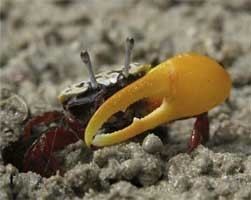Kingdom Animalia Subphylum Crustacea Order Decapoda Scientific name Uca mjoebergi | Phylum Arthropoda Class Malacostraca Infraorder Brachyura Rank Species | |
 | ||
Similar Uca annulipes, Uca perplexa, Uca panamensis, Uca crassipes | ||
Uca mjoebergi is a species of fiddler crab discovered by and named after the Swedish zoologist Eric Mjöberg (1882–1938), member of a Swedish scientific expedition to Australia in the early 1900s.
The crab is found along the north and northwest coast of Australia (approximately from Dampier to the Gulf of Carpentaria and on Papua New Guinea's northwest coast).
According to Crane, the species U. mjoebergi should be classified as a subspecies of Uca lactea, which in turn is a member of the subgenus Celuca. More recent works, however, classify the species separately in the subgenus Paraleptuca or subgenus Austruca.
Claw bluffing
Male U. mjoebergi rely heavily on their enlarged claw to signal dominance and fighting prowess. Crabs which lose their large claw will occasionally regenerate a lighter, cheaper claw (requiring less energy to produce). Research has shown that, while crabs with these 'cheap' claws are worse fighters than crabs with strong claws of a similar size, they are just as effective at intimidating other crabs based on claw size alone.
